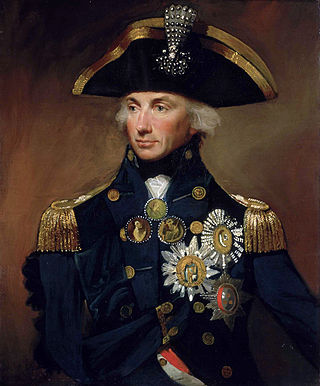
The Missa in angustiis, commonly known as the Nelson Mass, is a Mass setting by the Austrian composer Joseph Haydn. It is one of the six masses written near the end of his life that are seen as a culmination of Haydn's composition of liturgical music.

Missa in tempore belli is a setting of the mass by Joseph Haydn. It is catalogued Mass No. 10 in C major. Known also as the Paukenmesse due to the dramatic use of timpani, it is one of the most popular of his fourteen mass settings. The autograph manuscript contains the title "Missa in tempore belli" in Haydn's handwriting.
The Mass No. 13 in B-flat major, Hob. XXII/13, was composed by Joseph Haydn in 1801. It is known as the Schöpfungsmesse or Creation Mass because of the words "qui tollis peccata mundi" in the Gloria. He recycled music from Adam and Eve's final duet in The Creation, a fact which scandalized Empress Maria Theresa so much that she ordered Haydn to recompose that passage for her own copy.

The Missa Sancti Bernardi von Offida is a mass in B-flat major by Joseph Haydn, Hob. XXII:10, Novello 1, was written the same year as the Missa in tempore belli (1796), and it "may have been the first mass Haydn wrote after his return from England." Yet it may also have been the second. It is usually given as Haydn's ninth setting of the mass, though its Hoboken number is XXII:10. This mass was written in honor of St. Bernard of Offida, a Capuchin who devoted himself to helping the poor; a century after the friar's death, he was beatified by Pope Pius VI.
The Harmoniemesse in B-flat major by Joseph Haydn, Hob. XXII:14, Novello 6, was written in 1802. It was Haydn's last major work. It is because of the prominence of the winds in this mass and "the German terminology for a kind of wind ensemble, Harmonie," that this mass setting is called "Harmoniemesse" or "Wind Band Mass". Besides flute, 2 oboes, 2 clarinets, 2 bassoons, 2 horns in B-flat, 2 trumpets in B-flat, the mass also calls for choir, timpani, strings, and organ, the latter supplying figured bass for most of the duration.

The Missa Cellensis in honorem Beatissimae Virginis Mariae in C major by Joseph Haydn, Hob. XXII:5, Novello 3, was originally written in 1766, after Haydn was promoted to Kapellmeister at Eszterháza following the death of Gregor Joseph Werner. The original title as it appears on the only surviving fragment of Haydn's autograph score, that has been discovered around 1970 in Budapest, clearly assigns the mass to the pilgrimage cult of Mariazell, Styria. Until that discovery, the work was known as Missa Sanctae Caeciliae, or in German Cäcilienmesse, a title probably attributed to the mass in the 19th century. Whether the alternative title refers to a performance of the piece by the St. Cecilia's Congregation, a Viennese musician's fraternity, on some St. Cecilia's day, as has been suggested, remains speculation.
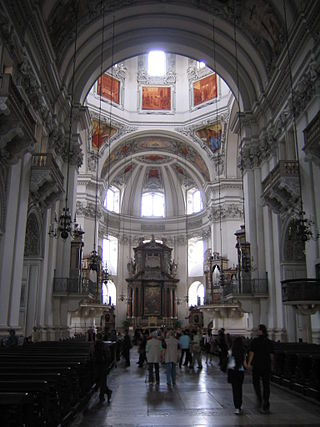
The Missa brevis No. 9 in B-flat major by Wolfgang Amadeus Mozart, K. 275/272b, was probably written before September 1777 for Salzburg. The mass is scored for SATB soloists, SATB choir, violin I, violin II, 3 trombones, string bass, and organ.

The Missa brevis in G major, K. 140, K3 Anh. 235d, K6 Anh. C 1.12, was probably composed by Wolfgang Amadeus Mozart shortly after returning to Salzburg, in March 1773, from his third trip to Italy.
Austrian composer, Michael Haydn's Missa Hispanica or Missa a due cori, Klafsky I:17, MH 422, was presumably written for Spain, but there is no evidence of its ever having been performed there during Haydn's lifetime. The mass is scored for 2 oboes, 2 bassoons, 2 horns in low C, F and G, 2 trumpets in C, timpani, strings, basso continuo, SATB soloists, and two mixed choirs.
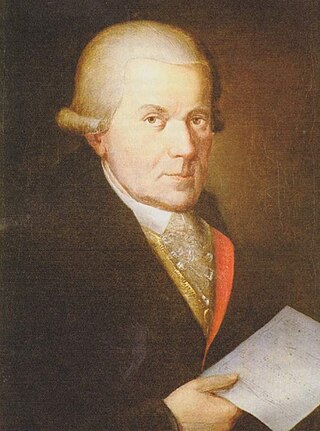
Michael Haydn wrote the Missa pro defuncto Archiepiscopo Sigismondo, or more generally Missa pro Defunctis, Klafsky I:8, MH 155, following the death of the Count Archbishop Sigismund von Schrattenbach in Salzburg in December 1771. Haydn completed the Requiem before the year was over, signing it "S[oli] D[eo] H[onor] et G[loria.] Salisburgi 31 Dicembre 1771." At the beginning of that year, his daughter Aloisia Josefa died. Historians believe "his own personal bereavement" motivated the composition. Contemporary materials which have survived to the present day include the autograph score found in Berlin, a set of copied parts with many corrections in Haydn's hand in Salzburg and another set at the Esterházy castle in Eisenstadt, and a score prepared by the Salzburg copyist Nikolaus Lang found in Munich.
Michael Haydn completed the Missa in honorem Sanctae Ursulae, Klafsky 1:18, MH 546, on August 5, 1793, probably for use at the ceremony in which Ursula Oswald, the daughter of a friend, professed her religious vows at the Benedictine Abbey of Frauenwörth Chiemsee. Because of that fact, the Mass is sometimes known as the Chiemsee Mass.

The Credo Mass in C major, K. 257, is a mass composed by Wolfgang Amadeus Mozart in 1776. It is scored for SATB soloists, SATB choir, violin I and II, 2 oboes, 2 clarini, 3 trombones colla parte and basso continuo.

The Missa solemnis in C major, K. 66, is a mass composed by Wolfgang Amadeus Mozart in 1769. It is scored for SATB soloists and choir, violins I and II, viola, 2 oboes, 2 horns, 2 clarini, 2 trumpets and basso continuo.
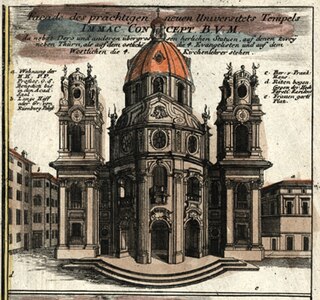
The Missa brevis in D minor, K. 65/61a, is a mass composed by Wolfgang Amadeus Mozart and completed on 14 January 1769. It is scored for SATB soloists and choir, violin I and II, 3 trombones colla parte, and basso continuo.
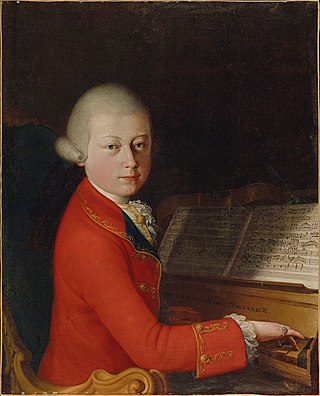
Mozart's Mass in G major, K. 49/47d), is his first full mass. It is a missa brevis scored for SATB soloists and choir, violin I and II, viola, and basso continuo.

Mass No. 1 in F major, D 105, is a mass composed by Franz Schubert in 1814. It is scored for two soprano soloists, two tenor soloists, alto and bass soloists, SATB choir, oboe, clarinet, bassoon, 2 horns, violin I and II, viola, and basso continuo. It was the first of Schubert's masses to be performed, and is of the missa solemnis type.

Mass No. 4 in C major, D 452, is a mass composed by Franz Schubert in 1816. It was originally scored for soprano, alto, tenor and bass soloists, SATB choir, violin I and II, and basso continuo. It is classified as a missa solemnis.

Mass No. 5 in A-flat major, D 678, is a mass composed by Franz Schubert, completed in 1822. There is no record of a performance during Schubert's lifetime. It is scored for soprano, alto, tenor and bass soloists, SATB choir with divisi, violin I and II, viola, flute, 2 oboes, 2 clarinets, 2 bassoons, 2 horns, 2 trumpets, 3 trombones colla parte, timpani and basso continuo. It is classified as a missa solemnis.
Missa Sancti Nicolai, Mass No. 6 in G major, Hob. XXII/6, also known as the Nicolaimesse, is a mass by Joseph Haydn, composed around 1772 and revised in 1802.

Missa cellensis refers to two masses by Joseph Haydn:











